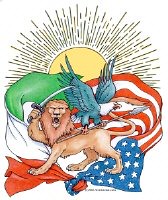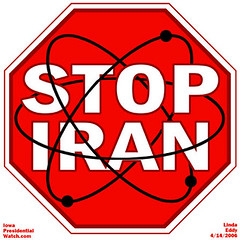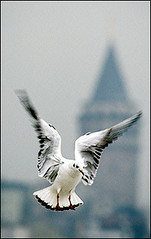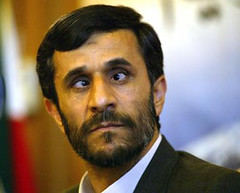Saturday, August 25, 2007
AMERICA KICKING ASS AT LAST
Subject: INTELLIGENCE REPORT: North Korean ships sunk by US Subs
US SUBS SINK N. KOREAN SHIP Click Here for source article
US Sinks a North Korean Ship Carrying Enriched Uranium Cargo for Iran in the past month, American naval and air forces have intercepted two North Korean vessels clandestinely en route for Iran with cargoes of enriched uranium and nuclear equipment.
The shutdown of Pongyong's nuclear facilities has made these items surplus to North Korea's requirements and worth a good price to the Islamic Republic.
Revealing this, intelligence and military sources describe the second incident in detail.
On July 12, the second intercepted North Korean freighter was sunk in the Arabian Sea by torpedoes fired from a US submarine 100 miles southeast of the Iranian navalbase-port of Chah Bahar.
Delivery of its freight of enriched weapons-grade uranium and equipment and engines for manufacturing more fissile material including plutonium in its hold could have jump-forwarded Iran's nuclear bomb and warhead project, lopping off at least a year of work.
For this Iran's rulers were ready to fork out $500million.
A few hours earlier, President George W. Bush received an intelligence briefing on the vessel, its freight - listed on official documents as a consignment of iron - and destination.
Sources report that the shipment was brought forward by several weeks to evade detection by UN nuclear watchdog inspectors who were to descend on Pyongyang this week to verify the dismantling of its nuclear facilities.
US airplanes had been tracking the freighter and picked up signs of radioactivity, indicating the presence of nuclear materials aboard.
Iran offers $1.5 billion for discarded North Korea nuclear items.
President Bush had the option of ordering US Marines to board the vessel or sinking it. He decided on the latter - both because the North Korean freighter was approaching an area patrolled by Iranian naval units and seizure of the vessel by American Marines might have provoked a clash; also so as not to expose US troops to radioactive contamination.
He therefore first ordered American naval and air units in the Persian Gulf, Middle East and seas opposite North Korea to go on a high state of readiness and torpedo the North Korean vessel without delay.
After the attack, US warships raced to the spot where the ship went down.They picked up three lifeboats. Most of the North Korean sailors aboard were either injured or dead.
Twenty in all died in the attack. They all bore symptoms of contamination.
After the episode, the area was cordoned off and underwater equipment dropped to salvage the cargo from the sunken ship.
All the parties to the incident, the United States, North Korea and Iran, have kept it dark. The situation in and around the Gulf is inflammable enough to explode into a full-blown Iranian-US clash at the slightest provocation.
There was also the danger of North Korea aborting the closure of its nuclear facilities at the lastmoment.
Last February, intelligence sources reported the Central Intelligence Agency warned the White House that Iran had offered North Korea a billion and a half dollars in secret negotiations for key components of its dismantled nuclear industry.
In March or early April, Kim Jong-Il decided in the interests of prudence to spurn the offer. He feared that if the deal leaked out to US intelligence, he could say goodbye to the rewards and benefits promised for giving up his nuclear weapons.
But on second thought, the North Korea ruler decided it was worth taking the risk of a limited deal with Iran and he therefore agreed to
1. Subtract for Iran a portion of enriched uranium from his stock.
2. Make up some of Iran's shortages of high tech equipment for manufacturing weapons.
3. Lend Tehran dozens of nuclear engineers and technicians who have been put out of their jobs by the shut down of North Korean's program.
With their help, Iran can speed up its program. Intelligence sources report that three senior North Korean engineers are due in Tehran by August 20 and another nine in December.
By then, North Korea expects the IAEA certificate confirming the closure of its nuclear program to be safely in the bag.
Tehran is also giving North Korea three years' supply of free oil.
The CIA knew about the North Korean deliveries and knew they would be disguised as iron shipments, but were not clear how many ships would be used.
France helps net the first suspect North Korean freighter.
Over several weeks, the Americans cast a dense net of maritime and aerial surveillance, co-opting friendly Asian and European air and naval forces, to keep tabs on every vessel departing North Korea with freights of iron.
The first North Korean vessel was caught in the net on June 25.
Suspected of carrying radioactive materials hidden behind a cargo of iron, the vessel had entered the Arabia Sea and was two days voyage from Iran when, according to sources in Paris, President Bush and French president Nicolas Sarkozy had a quick conversation over secure lines.
That exchange resulted in a decision to rush US and French naval units in the neighborhood to intercept the suspect North Korean freighter and blow it out of the water.
Much about the incident remains under tight wraps. It is not clear whether the ship was sunk by an American or a French submarine and, even after the event, it is not certain that the doomed ship did in fact carry nuclear materials or equipment.
Three days later, on June 28, the US Navy released this statement:
US sailors helped rescue the crew of a North Korean-flagged ship on Monday.The incident occurred in the Arabian Sea when the ship reported it had engine problems, no food or water and was in danger of sinking.
The USNS Kanawha and the French ship Dupleix helped evacuate the ship's 16 crew members to safety. None of the crew was a NorthKorean citizen.
The US and French ships are part of Combined Task Force 150, which conducts maritime security operations in the Gulf of Oman, the Gulf of Aden, the Red Sea, the North Arabian Sea and parts of the Indian Ocean. The Military Sealift Command ship in the US Naval Fleet is the USNS Kanawha.
Sources note that before these two episodes, the last time the US Navy or Air Force directly attacked a North Korean vessel was in December 2002, four months before the invasion of Iraq. That operation was also carried out in conjunction with a European naval force.
The CIA located in the Indian Ocean a North Korean freighter carrying a disguised freight of Scud missiles bound for Saddam Hussein's army in Iraq. The missiles were to have been unloaded in Yemen and smuggled into Iraq.
The ship was boarded by Spanish marines under the cover of American helicopters.
"Russia signs a mammoth arms deal running into tens of billions of dollars for the sale to Tehran of 250 Su-30MKM warplanes and 20 IL-78 MKI fuel tankers.
Iran has stipulated delivery of the first aircraft before the end of 2007. The transaction, Russia's largest arms deal in 30 years, will endow Iran with a long-range aerial assault capability.
The Sukhoi can sustain a four-and-a-half hour raid at its maximum range of 3,000 km against long-distance, marine and low-lying ground targets across the Persian Gulf and Middle East, including Israel and Lebanon.
The fuel tankers extends the Su-30MKM's assault sustainability to 10 hours and its range to 8,000 km at altitudes of 11-13 km. The closest comparable plane in the West is the American F-15E fighter bomber.
Iran's acquisition of an exceptionally large fleet of the Russian fighter-bomber will elevate its air force to one of the two largest and most advanced in the region, alongside the Israeli Air Force.
Iranian air crews are already training on the new Sukhoi aircraft, ready to start flying them early next year with only a short delay after delivery.
Moscow is selling Tehran the same Sukhoi model as India received earlier this year.
The Iranians leaned hard on New Delhi to let them have the Israeli avionics and electronics the Indian Air Force had installed in the Russian craft. India refused.
Russia began delivering the same craft in June to Malaysia, which also sought Israeli avionics without success.
The Su-20MKM has won the nickname of "Islamic Version of Sukhoi." Its two-member crew shares the workload. The first pilot flies the aircraft, controls weapons and maneuvers the plane in a dogfight. The co-pilot employs BVR air-to-air and air-to-ground guided weapons in long-range engagements, sweeps the arena for enemy craft or missiles and performs as command-and-control in group missions.
Subscribe to:
Post Comments (Atom)














1 comment:
Hi. Your post was forwarded to me by Walter E. Wallis.
We both would be hugely thrilled if it is true, and I would love to carry it in my blog www.orbat.com.
Problem is, I need some reasonably credible source to attribute.
We often carry stuff from debka.com, and debka is right less than half the time. But still it gives me a source that people are familiar with.
Please help me out here.
Best,
Ravi
Editor
www.orbat.com
Post a Comment